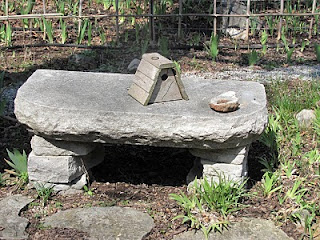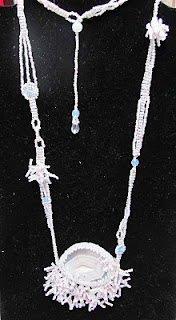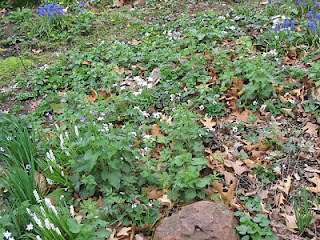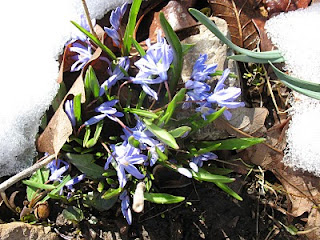As if plants aren't art enough, many of us have an overwhelming desire to put objects in among the foliage and flowers. For some, it's gnomes, plastic flamingos, cutesy painted stuff ala Mary Englebright; for others, it's statuary, birdbaths, Japanese lanterns, gazing balls. There are folks who like things like bowling balls, bottle trees, various rusty old farm and garden machinery, old tools, even an old pickup or two (just kidding--or not!). Avid flea market hunters dote on old painted lawn furniture, vintage rakes, plant stands, antique gates and even weathered wood tool sheds. I have a friend who actually drug home an old boat that she used as a fish pond! People bring home all kinds of crafts and souvenirs from trips, craft fairs and amusement parks and display them in their gardens. Any of a thousand mail order catalogs sell cute garden animals in all sorts of poses, tree "faces", signs, stepping stones, lights; just about anything somebody's imagination can conceive will appeal to somebody. Big box stores are full of things; gift shops and garden centers appeal to our senses of amusement, amazement, and the "aaww!" factor with an astonishing array of garden "art" accessories.
Then there are the artists and crafts people, who create their own works and display them, often for sale, in their own gardens and public gardens as well. Books have been written about them, describing pieces as "quirky", "a sense of style", dreamlike imagery", exuberant", "funky". Just like in a museum, art pieces in a garden tend to have descriptive phrases attached to them according to how "outre" they are in character, which can range from the elegant to the plain trashy, depending on the eye of the beholder.
There are gardens which are works of art on their own. Japanese gardens, with their own sense of style, rely on stone, mosses, pruned and trained plants that are sculptures in themselves, with rules of placement that are sacrosant, in traditions that are centuries old. Topiary gardens are living examples of garden art, and modernist gardens rely on architecture as much as they do on plants. Creations of some landscape gardeners are as much art as any object carved of stone, wood or cast in bronze.
I, for one, and for a lot of people I know, (possible influenced to some extent by the many garden books and magazines I've read) tend to be more or less eclective in collecting objects for my garden. I also belong to the generation of "use it up, make it do", which, combined with my artistic sense and love of shapes and textures, puts me somewhere between the scavengers, the flea market crowd and the artists. I love to create, and my garden is as much a creation as the objects d'art (laughingly) that I decorate it with.
Part of "art" is a sense of fun, but just as important to me is placement. We have all seen tiny front yards populated with dozens of yard ornaments that outnumber the flowers, making you wonder however those people manage to mow the lawn! Though I recycle and create any number of things for garden use, they aren't on display like a group of whatnots on a shelf. Among all the plants and flowers, you come on many of them like little surprises. My dry creek is populated with a collection of frogs that you have to look closely to notice. A small collection of lizards hangs out here and there among the wild flowers and trees; you might not see them until they are right in front of you. A pair of vintage, lichen encrusted benches await you by the paths in the woods, and just for fun, a trio of tree branch "sculptures" resembling nothing so much as a family of Ents marching through the trees. These replace a group of huge grapevine balls that rolled about the wood as the wind took them, a few years ago.
Closer to the house, in the daylily garden just off the deck, there is yes, a bottle tree! I found myself fascinated with the lore of them last summer, and had to have one! This one was made with a branch taken down from an oak tree by The Ice Storm of 2007, as we remember it around here, and blue bottles were collected over the winter. I enjoyed emptying some of Riesling; others came from friends and the local recycling center. It spent the winter on the deck but is now in its more or less permanent place surrounded by daffodils and red Greggi tulips which have yet to bloom this spring.
I do have fun with recycling and repurposing things, too. Old rusty kitchen graters become candle difusers, twinkling like fairly lights after dark. Clay drain tiles standing on end and filled with sand also hold votive lights (citronella in the summer) when we have a garden party.
A discarded fireplace insert becomes a patio fireplace; a huge cedar stump topped with a flat stone becomes a garden table.
And I do love vintage plant stands! One is topped with a vintage floor grate. A discarded fire hydrant fitted with a waterline and faucet bib helps keep the herb garden watered; 1940's era metal chairs provide comfortable seating throughout the garden. An old round galvanized tub with a liner and an antique pump (non working) holds a purple taro and water hyacinths, and a real frog or two in the summer. A garden table is made with a concrete top that was poured into an old barrel ring (a project with my granddaughter when she was 8), decorated with tiny heart-shaped ceramic tiles, and supported by three left-over clay drain tiles.
The Yardbird was inherited.
Various vintage tools and found things decorate the tool shed and studio, and hang on the fence that separates the back yard with the beginning of the woods gardens.
Small logs from trees that either fell in The Ice Storm or were thinned out of the woods make a rick-rack fence along the woods, and a rainbow of irises lines the roadside.
A limestone bench came from a porch that was being dismantled; our driveway/parking area is constructed of concrete slabs from our own front porch that was broken up when our house was remodeled. (see above behind the patio fireplace) It also provides extra seating when we have a large garden party! A pair of huge planters recovered when a fast-food restaurant was re-landscaped (my husband was the landscaper and hauled them off) are filled with chrysanthemums that spill over the sides in the fall. A fancy old child's bed iron headboard becomes an herb garden gate; a piece of concrete architectural salvage found by the side of the road becomes a birdbath base. And of course, being Airstream owners, (kind of a weird little quirk we have) there have to be plastic flamingos somewhere, and there are, by the pond among the irises.
No garden would be complete without a toadstool. This was once a garden light.
Art, as they say, is truly in the eye of the beholder.
A couple of my favorite books: "Artists in Their Gardens" by Valerie Easton and David Laskin; and "Garden Junk" by Mary Randolph Caarter


























































